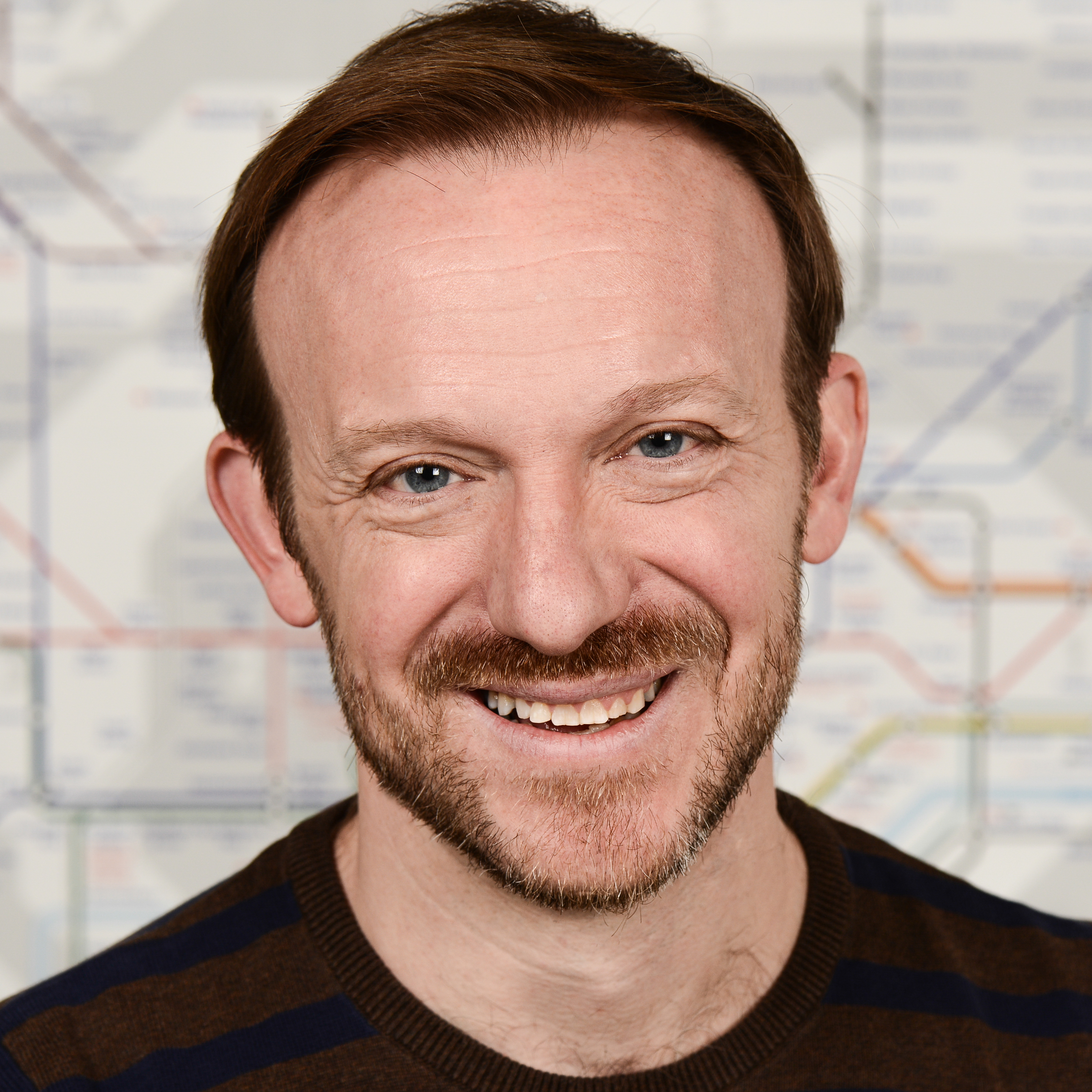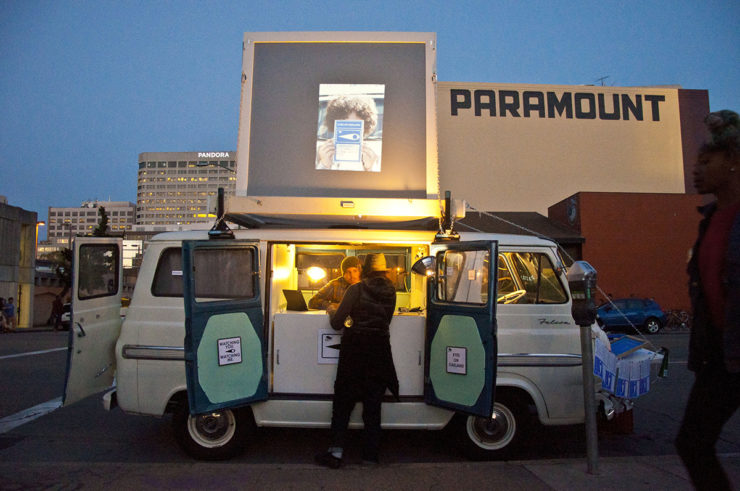
Roy, an artist who grew up in rural North Dakota and concentrated in visual and environmental studies at Harvard, creates work that helps people navigate numbers. In the spring of 2015, she and Golden packed a half-dozen artworks—including the aforementioned cow, a wool sculpture in the colors of a brook trout depicting the “fuzziness” of climate change statistics, and a farm faucet mounted on a pedestal of different-colored woods to represent pesticide contamination—into a U-Haul for a seven-city Wisconsin Center for Investigative Journalism roadshow. Roy and Golden went to Madison, Eau Claire, Green Bay, and La Crosse, among other cities, where Roy’s visualizations of the state’s water issues sparked conversations about pollution, conservation, and other environmental problems.
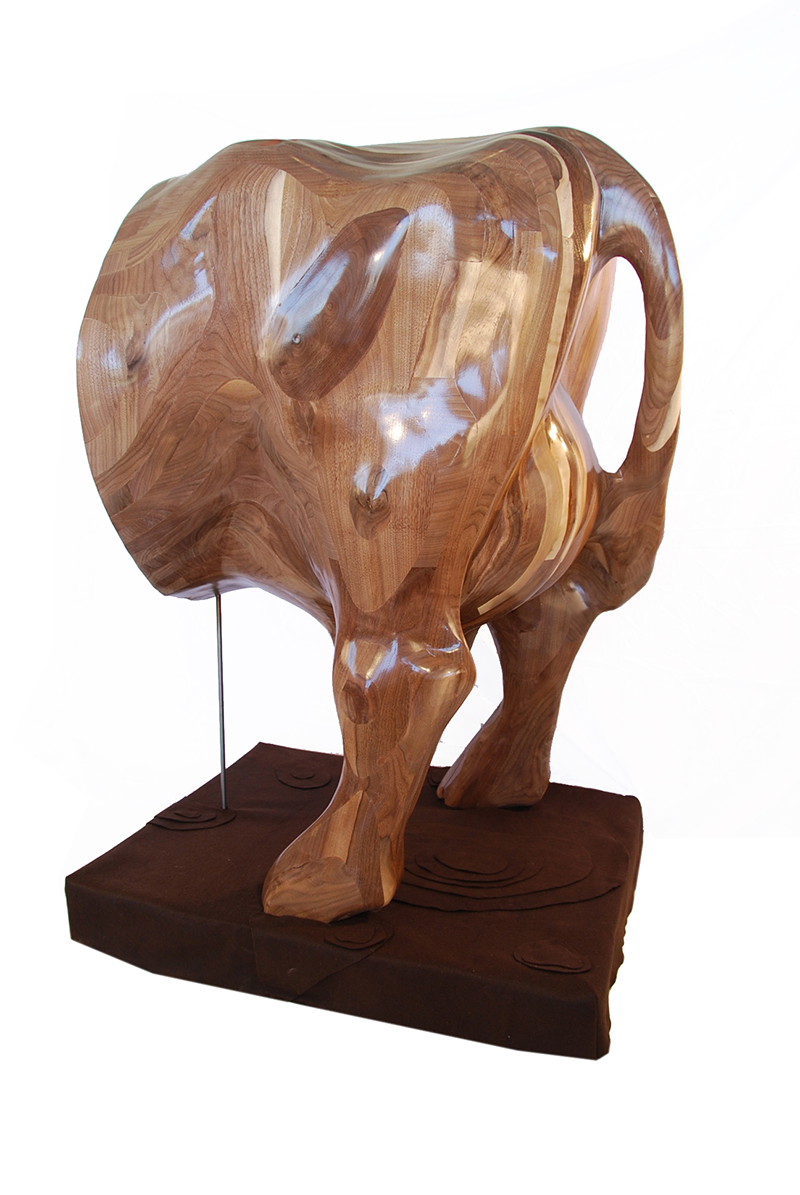
Carrie Roy’s sculpture draws attention to the link between cow manure and water pollution
The exhibits brought in people who may never read through an investigative piece—or go to a typical art show for that matter. Roy and Golden found themselves talking with a retired water engineer, a veterinarian who was also a woodworker, and a beer brewer concerned about clean water, among others, each spurred by the art to talk about the issues around water use in the state. “We ended up getting a lot of people who were thoughtful about these issues,” says Golden. “I’m interested in media that people can feel and see in person because it makes things more real for them. Sometimes charts and graphs can really lack an emotional connection. When [Roy] turns them into art, it helps connect those numbers to what is really happening and affecting people.”
The Wisconsin Center for Investigative Journalism project is one example of how journalists are employing the arts to get important issues off the page and screen and into people’s lives. At the same time, artists are beginning to employ reporting techniques, using interviews, public records, documentary footage, and photo captions to create work addressing social, economic, and political topics that usually fall within the purview of journalism.
In the early 2000s, the Russian art collective Chto Delat (“What Is To Be Done?”) published a newspaper filled with trenchant political commentary on post-Soviet Russia. Since 2008, Chicago-based Temporary Services has produced over 100 booklets, pamphlets, and newspapers—through its publishing house, Half Letter Press—that frequently criticize the art world’s exploitation of unpaid labor. More recently, Dushko Petrovich, a surrealist painter and adjunct professor at Yale, released a one-issue satirical newspaper called Adjunct Commuter Weekly (subsequently relaunched as the webzine ACW). The publication highlights the predicaments of legions of part-time professors who travel between campuses by plane and train to make ends meet. Through projects like these, journalists and artists alike are finding complementary ways to tell stories and engage audiences.
Art and journalism began converging sometime around the French Revolution, when images representing contemporary social conditions and politics began to appear in the work of artists like Francisco Goya and J.M.W. Turner. For his 1819 oil painting “The Raft of the Medusa,” depicting with savage realism the wreck of a French frigate and subsequent stranding of the crew, in which all but 10 of the 150 people onboard perished, Théodore Géricault exhaustively interviewed two of the survivors. And, of course, political cartoons have been a staple of American journalism since Ben Franklin published a fractured snake with the caption “Join, or Die,” creating a mashup of art, satire, and politics that has been distilling complex issues down to pithy images ever since. In the 20th century, photographers Walker Evans and Dorothea Lange documented the poverty of the Great Depression for the Farm Security Administration with bleak but highly stylized images, while Henri Cartier-Bresson made pictures that are works of both art and reportage. Even Norman Rockwell—best known for his saccharine lithographs of rural Americana for The Saturday Evening Post—painted a series of canvasses in the early 1960s exploring the civil rights struggle.
By the 1960s and ’70s, conceptual artists like Hans Haacke and Dan Graham were using the language and structure of investigative journalism to comment on controversial social and political topics. In a project at the Museum of Modern Art, Haacke set up two plexiglass ballot boxes and, using the language of newspaper polls, asked museumgoers to voice an opinion about the fact that New York Governor Nelson Rockefeller, who was a museum trustee, had not denounced President Nixon’s bombing of Cambodia. In another show, this one at the Guggenheim, Haacke used public records to expose the real estate and financial networks behind one of the Lower East Side’s biggest slumlords, presenting the information with photographs of buildings, captions, charts, and graphs. The museum cancelled the show before it opened, deeming it “inadequate” for an art institution.
“All art bears witness in some way to history or individual experience,” says Jennifer Liese, director of the writing center at Rhode Island School of Design and editor of “Social Medium: Artists Writing, 2000–2015,” a collection of writing by contemporary artists due out this summer. The difference between journalists and artists, she argues, is “art does this explicitly and intentionally” while journalism tries to take a more objective, or at least dispassionate, view. “Journalists and artists in a lot of ways play a similar role in society,” says Heather Chaplin, director of the Journalism + Design program at the New School in New York. “They are both supposed to be telling us the truth about our society even if it’s truth we don’t want to hear.”
While journalism in its most traditional sense may have focused on factual reportage, there has always been an artfulness to the craft, from how reporters order their material to narrative storytelling techniques. Chaplin argues that digital technology and increased competition have led journalists to employ more creative techniques to capture viewers’ attention, including multimedia storytelling, stylized visuals, and interactive techniques to create a more personal and emotional experience. “It’s no longer possible to say people are going to read this just because it’s important,” she says.
To present statistics in a way that fosters public engagement, hire an artist
Such “aesthetic journalism” has dovetailed with a burgeoning activist impulse by artists to engage with politics and world events. If journalism marshals its techniques to provide a view on the world, then art provides a “view on the view,” a way to question our assumptions about how we perceive the world, says Alfredo Cramerotti, director of MOSTYN, a publicly funded art gallery in Wales, and author of the book “Aesthetic Journalism.” “Journalism proposes a certain perspective and uses a number of elements to make it valid. The work of an artist and the value of artistic practice is in taking a perspective and shifting it slightly so it becomes something else.”In creating that shift in perspective, argues Cramerotti, artists have long assumed the tools and techniques of journalism without making them apparent—or perhaps without even realizing it themselves. Cramerotti had firsthand experience with this when, in 2003, he was commissioned to make a work about a bridge in Istanbul connecting Europe and Asia, and produced a sound installation involving interviews with residents. “I realized I was commissioned to make an artwork, but came back with a journalistic installation,” he says.
The same digital technology that has allowed journalists to experiment with new artistic forms has also propelled artists to experiment with new means of documentary production and dissemination. One artist who has played with such forms is Santiago Mostyn, who was born in San Francisco, grew up in Zimbabwe, Grenada, and Trinidad, studied at Yale, and is currently based in Stockholm. Back in 2012, Mostyn was in a month-long residency in Istanbul, and asked people what places in the city were special to them. By chance, they coincided with places the Turkish government monitored via security cameras, which could be viewed online. Mostyn went to those places and was filmed himself.
In 2013, he was back in Stockholm when the Gezi Park protests broke out in Istanbul. He immediately went to the surveillance websites again and began editing footage of the battles between protesters and police—then put them together in an art piece called “Double Take: Istanbul’s Streets Then and Now,” which juxtaposes images of relaxed crowds shopping in urban markets with riot police hosing down protesters with water cannons. As much as it foregrounds the familiar scenes of violence, the contrast equally draws the viewer’s attention to the normalcy of the previous footage, humanizing the scene in a way most media reports of the Middle East and surrounding areas don’t. He is currently at work on a project in which he rowed an open boat across the sea from Turkey to Greece, a treacherous crossing for migrants, changing the view of that area from the one we are familiar with from news footage.
Mostyn’s work was commissioned by Creative Time Reports, a Web-based platform for artists to comment on national and world affairs. The publication—a project of Creative Time, an organization that has commissioned public art in New York City for decades—has partnered with The Guardian, Foreign Policy, and Al Jazeera, among other titles, to publish articles, on everything from government surveillance to mass incarceration to racial discrimination, by artists like Ai Weiwei and Marina Abramovic. “We’ve always believed in the power of artist’s voices to weigh in on society and bring something unique and engaging to the public,” says Marisa Mazria Katz, a journalist who has been published in The New York Times, Financial Times, and elsewhere, and has edited the site for four years.
Another artist the organization has commissioned is Trevor Paglen, who has used photography and filmmaking to investigate surveillance and security issues. For “Watching the Watchers,” Paglen flew a helicopter over the headquarters of the National Security Agency (NSA) and other U.S. government surveillance agencies to capture nighttime aerial photographs of their campuses. He published the images on The Intercept, a news site—created by Glenn Greenwald, Laura Poitras, and Jeremy Scahill—that focuses on government secrecy. Paglen’s landscapes are moody and deliberately sinister, revealing the massive size of the agencies at the same time failing to provide any glimpse at what goes on inside.
The artworks present a view of the U.S. surveillance apparatus dramatically different than the one that would appear in a strictly journalistic work, says Katz: “A journalist can write about the billions of dollars these agencies are receiving and unpack a trove of rare documents, but what [Paglen] strives to do is create a visual culture around something that is so obscure.”
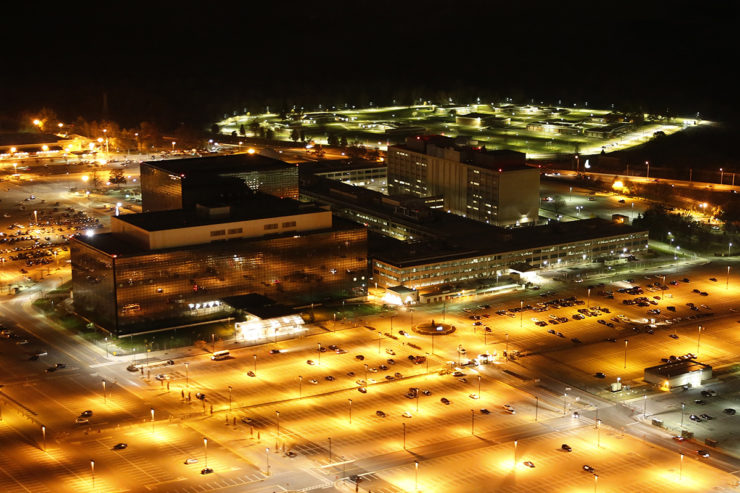
Trevor Paglen intends to provoke questioning with his images of the NSA’s campus
Others have seen art photography and photojournalism as less in opposition to one another so much as on a continuum. “The image has an uncanny authority which can cut both ways,” says Susan Sterner, a former staff photographer for the Associated Press who heads the New Media Photojournalism program at the Corcoran School of the Arts & Design in Washington, D.C. On the one hand, a photo can seem like a much more authoritative vision of reality; on the other, a photograph always includes an element of contrivance that moves it toward the realm of art “through the lines you are choosing and what you decide to photograph.”
Sterner’s program consciously works to break down distinctions between art and journalism, helping journalists to experiment with new ways to make their images stand out. As a successful example of that trend, she points to Washington Post journalist Dave Burnett, who shot the 2004 presidential campaign with an old-school 4×5 black-and-white camera. With the large-size negatives he was able to produce photos with much greater detail and contrast in a way that seems to slow down and isolate the subject in space. “You can create more nuanced work when you allow yourself to think outside the profession’s boxes,” says Sterner. More recently, Dallas Morning News photographer Mona Reeder set out in a photo essay called “The Bottom Line” to illustrate Texas’s skyrocketing youth incarceration rate and other statistics with provocative, highly stylized photos of children in prison and inmates on death row.
Outside of some ethical guidelines—for example, that photojournalists in general document events as they transpire, while fine art photographers are more apt to compose and orchestrate the subjects of their images—Sterner says that the difference between the genres has much more to do with audience and intent, and sometimes, simply the venue in which it’s shown. We look at a photo very differently in a newspaper from one on a gallery wall. “When something is on the wall, the scale changes,” she says. “You have to move and approach it. It’s a more physical experience. You are meant to lose yourself in the work.”
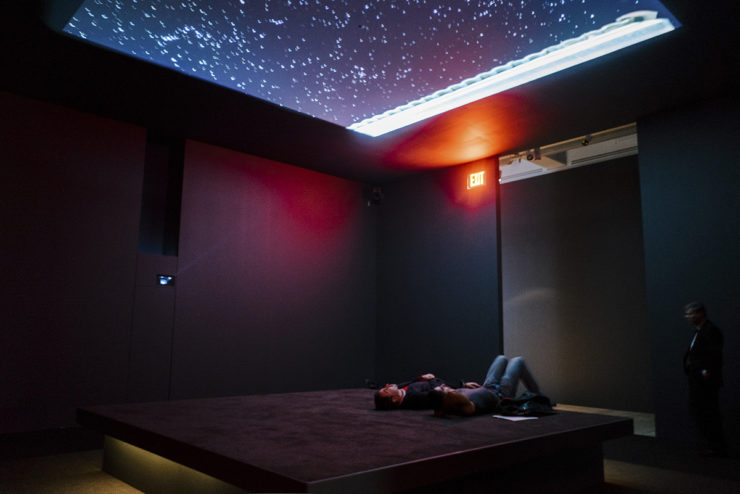
Visitors to the Laura Poitras exhibit are invited to gaze at a video of the skies over Yemen, Somalia, and Pakistan where drone wars are conducted
An art exhibit by Laura Poitras builds on her print and documentary work, but in a more personal and physical way
That’s also true of the arresting drawings of Molly Crabapple, an artist who has travelled from Gaza to Guantánamo Bay to write and illustrate pieces for The New York Times, Vice, and Vanity Fair. As a teen, Crabapple was drawn to the work of Henri de Toulouse-Lautrec, who hung out in cafes with writers and anarchists and painted the demimonde of Paris. “I always dreamed about this role for artists as very much involved in the world and as documentarians of it,” she says. “I am much less interested in art that is of someone’s internal state but impenetrable to others.”
Back in 2011, Crabapple was living across from Zuccotti Park as the Occupy Wall Street protests broke out. Her apartment became an ad hoc pressroom for reporters who needed a place to plug in their laptops. “The more time I spent with journalists,” she writes in her recently published memoir, “Drawing Blood,” “the more their techniques rubbed off on me—like glitter, or a rash.” Her work became increasingly political, and she spent weeks researching dense allegorical works taking on topics from the Tunisian revolution to the global financial crisis. In 2012, she started practicing journalism herself, travelling to Greece with British journalist Laurie Penny to create the e-book “Discordia,” about the Greek debt crisis. Crabapple sketched subjects while Penny interviewed them.
“It’s much easier to disarm people when you are sketching,” Crabapple says. “People feel very alienated when they have a camera shoved in their face. I am kind of quiet when I am doing a sketch, and people will really talk to me.” She also feels her artist’s eye allows her to notice details other journalists might miss—like a chart at Guantánamo Bay encouraging guards to rate their “spiritual health” on a five-color scale from red to green—and by sketching scenes she can cause a viewer to look differently at themselves and the issues.
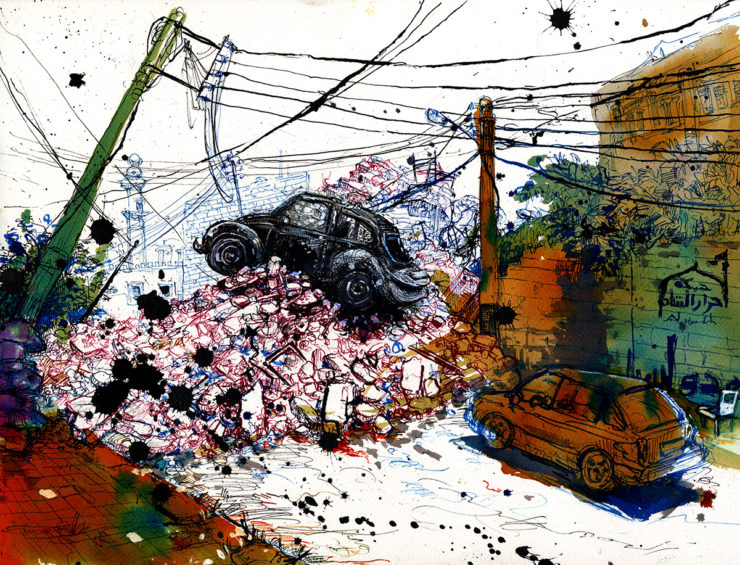
With her sketches based on a photographs, Molly Crabapple provides Vanity Fair readers with a look at wartime scenes from Aleppo, Syria
Each sketch took more than eight hours for Crabapple to make; each has only a few colors, with some parts finely detailed and other parts hastily sketched, with ink blotches scattered across the page. Since publishing the first part of the series in the fall of 2014, however, Vanity Fair story editor Kia Makarechi says the publication has been overwhelmed by the positive response, with many people sharing the images on social media. “Many people remarked on how beautiful the package was,” says Makarechi, a strange response for what is essentially a piece of war reporting. The contrast between the ugliness of the subject matter and the attractiveness of Crabapple’s art, however, helped draw readers into the package, including the accompanying text by Crabapple’s source, who wrote a heartbreaking essay about how rebel rule has transformed life in Aleppo.
Jointly hiring an artist-in-residence is a first for three Alabama newspapers
While artists like Crabapple, Mostyn, and Paglen use journalistic techniques to create their unique views of the world, some news outlets are using artistic techniques to change the way they connect with audiences. Hoping to expand the scope of its storytelling, the Alabama Media Group, which runs The Birmingham News, The Huntsville Times, and Mobile’s Press-Register, as well as statewide news website AL.com, hired its first artist-in-residence—Jennifer Crandall, a video journalist who produced a successful series of short profiles for The Washington Post called onBeing, featuring a diverse range of Washingtonians sharing their “musings, passions, histories, and quirks.” Each video features a person—a Muslim beauty pageant winner, a 7-year-old fan of rap and metal, a white guy in a blazer talking about his pet peeves—presented against a white background simply talking to the camera about what his or her life is like. In the aggregate, they are touching, intimate, surprising, and strangely addictive. It’s no surprise, meanwhile, to hear that, although she attended journalism school at the University of Missouri, Crandall never quite felt at home as a journalist. “I’ve always been someone who has been asked to fit within these boundaries,” she says. “I straddle them somehow.”
For the Alabama Media Group, she crossed boundaries, literally and figuratively, as she traversed the state, recruiting Alabamians for a video project about their state and Walt Whitman. Participants read one of the 52 sections in Walt Whitman’s “Song of Myself,” which Crandall invited them to do in the way they wanted and in an environment of their own choosing—from high school football games to horse farms to living room easy chairs. Crandall chose Whitman, a white Northerner who worked as a nurse during the Civil War, to play with the contradictions and complications of American identity. “Walt Whitman is seen as the American writer, and yet he’s a Yankee,” she says. “I wanted to cheekily co-opt that.” As the Alabamians—young and old, black and white—read the words, they let down their guard revealing a more vulnerable side of themselves, at the same time the poet’s words offer a grand celebration of humanity—making the videos feel individual and universal at the same time.
The Alabama Media Group plans to release the 52 sections serially over the next year, as a collaborative project among the artist, the journalists, and citizens. The project “allows this to feel so much bigger than when people narrowly speak from their own experiences,” says Michelle Holmes, vice president of content at Alabama Media Group, citing Whitman’s exhortation that his readers, “not look through my eyes” but “listen to all sides and filter them from yourself.” By asking readers to step outside their comfort zones, Holmes and Crandall hope viewers will be inspired to consider, even re-consider, what it means to be an Alabamian, an American, and a human being—something both great art and great journalism do especially well.


